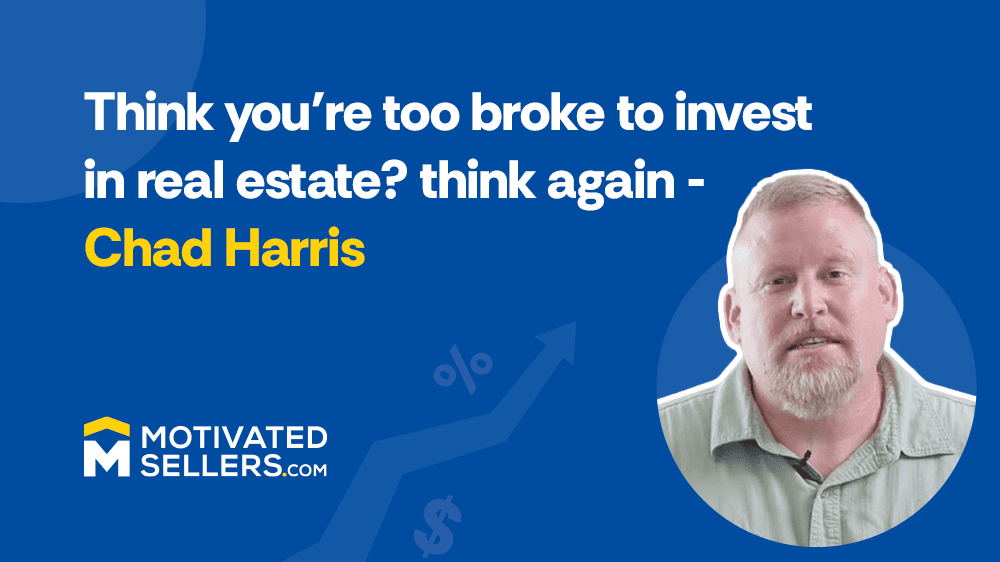

Today we are sharing a story that will surely inspire you. Our guest is a self-made real estate investor who built a portfolio without relying on traditional bank financing.
When his teaching job ended in 2012, he was driving a borrowed car, living in a borrowed house, and had mounting bills to pay.
Chad Harris committed to investing in real estate without any capital, but he gave his all. He used the BRRR method to scale his business and continue building trust with private lenders.
Chad admits that being broke is not the ideal way to start investing in real estate. It was a dark point in his life. He was working in Kenya and came to the U.S. for the birth of his fourth and youngest child. His son had health issues, which made flying back to Kenya impossible. Their house was provided by the church. It was a tough time with mounting bills.
It was a dark period when I decided to become a buy-and-hold investor. I had no idea what I was doing, but I made a commitment to myself: every day, I would go out and tell people that I was buying houses.
The interesting thing was that everyone I encountered wanted to invest in real estate. So I realized there was an opportunity to help them. They could act as the bank and lend me the money for the purchase and rehab.
Earlier, I had raised money for ministry, so I was familiar with those types of financial conversations. My strategy was to use private money on the front end for the purchase and rehab. Once the house was rented, I would refinance with another long-term private lender. That’s how I bought my first 25 doors.
Then I figured out creative financing options, including seller financing. My entire portfolio was acquired without ever getting a bank loan. It was a road less traveled, but it worked out for me.
Human beings are afraid of loss and risk. I had almost nothing to lose. My back was against the wall, which gave me the courage to push back. For any type of serious success, you must burn bridges and commit to the process.
My first investment was in 2013 in Dayton, Ohio. In our area, the economy was based on the automotive industry, which had just collapsed. Properties were being foreclosed left and right as people moved out of town to find jobs. I invested in undervalued properties where the price range was $15,000 to $18,000. The properties required some work, especially new plumbing. Back then, plumbing was often stolen when metal prices were high.
After renovation, the biggest challenge was finding qualified tenants because of the declining population in Ohio.
My numbers made sense. After rehabbing, those properties were valued at $50,000, so I could take a $40,000 loan for refinancing. Thankfully, it was the end of the recession, and home prices started to rise.
Finding a foreclosed property was not hard in 2013. The challenging part was finding lenders and placing qualified tenants in those homes. My focus shifted to direct-to-seller marketing after completing 10 deals. As of today, I continue marketing directly to sellers. I use MotivatedSellers.com, which allows me to speak directly with sellers.
One of my lead generation secrets was that I was good on the phone. I genuinely wanted to help the seller. I am also a public speaker, and my public speaking work also attracts leads.
Newbie investors often focus too much on themselves, which puts them under pressure. Shift the focus to the homeowner and the entire conversation becomes smoother.
There’s a powerful quote from Zig Ziglar: “You can get everything in life you want if you just help enough people get what they want.”
It’s 100% true when dealing with motivated sellers. Understand their pain points and motivations. Help them achieve what they want, and you’ll naturally receive what you desire.
Even with creative financing, I always present the seller with two options. They can sell for $150,000 or receive $1,000 per month. I’ll pay a specific sum at closing and then continue monthly payments. The homeowner can choose the best solution for their situation. I never discuss underlying strategies or real estate jargon because sellers don’t care about that. They just want a quick and guaranteed solution.
We have one part-time assistant and a leasing agent. Our management expenses are around 2%. The key is having a good checklist:
There should be a clear list outlining your next step in every situation. Once you have that, you can train anyone to follow it. Simple checklists can also be used for property acquisition, closings, and managing contractors.
My most challenging moment in the business came during a period of growth when I faced difficulty paying my contractors. The payment would be due on Friday, and by Wednesday, I would have no idea how to make it. That’s when having a personal cash reserve proved invaluable.
Today, investors are overwhelmed by information overload. You can watch videos, but applying that information personally is difficult. Most investors struggle because they are doing it alone. In difficult situations, it’s easy to feel like you’ve failed or that you’re the first person to face such challenges—which isn’t true. Surround yourself with successful investors, and you’ll realize that nobody succeeds without going through hard times. Failure is just part of the journey.
Private money is the best choice for real estate investors. There are opportunities everywhere. Many people who previously invested in the stock market now prefer safer, asset-backed investments due to market uncertainty. They can earn better returns by offering collateral-backed loans.
It becomes easy to raise private money once you learn how to do it and have a record of buying undervalued properties, creating forced appreciation, and generating consistent rental income. The best private lenders often have never heard of lending money on a real estate deal. You have to share your story so others can participate. Educate prospective lenders on the potential returns and the hassle-free nature of the process.
The real estate market in Dayton, Ohio, is cooling off. Inventory is rising, and prices are holding steady for now. It’s a good opportunity for buy-and-hold investors. The rental market remains strong as high interest rates make homeownership less affordable. The situation might not be ideal for rehabbers, but it’s favorable if you’re building a long-term portfolio.
My oldest son is 19 and has started to invest. My advice to him would be to put that $10K in the bank and use it as reserves. Go out, share your story, and raise money from private lenders. Fulfill your commitments and purchase rental properties at a discount.
My son's first rental was purchased at under 70% of ARV. After refinancing, he will make $350 each month. He just needs to recycle that money repeatedly. It’s only a matter of time before he earns freedom, both financially and time-wise.
The podcast True Wealth Investors is all about building your dream life one door at a time. Some episodes focus on creative financing, while others are centered around buying rentals.
The quote from Zig Ziglar is my favorite: “If you make a commitment to succeed in life, you will.” Commit today to being successful in real estate. Even if you have no idea how you're going to do it, just commit to it and you'll figure out the rest along the way.
For our podcast audience, we’re launching a new program in August 2025 called One Rental to Freedom. The focus is on buying your first rental using private money and then recycling the yield to scale.
On a personal level, my oldest son has joined real estate investing. My second oldest is about a year away. I’m excited to make it a family affair and expand my vision for the business to include my family.
That concludes our conversation with Chad Harris. You can connect with Chad through his Facebook group, "True Wealth Real Estate" podcast or his website truewealthinvestors.com.